The Division 2's Washington DC is a more open world, and a more dangerous one
Combat feels extremely familiar, but there's a few new weapons, a couple new enemies, and even some new allies.
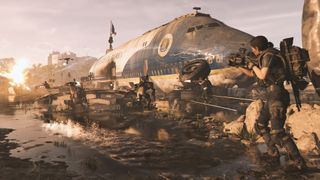
We've already gotten some details about The Division 2 from Ubisoft's E3 press conference: it's set in Washington DC this time, it will feature 8-player raids, free episodes every three months after launch, and it's bucking the trend by saying 'nope' to a battle royale mode. The demo of The Division 2 I played at E3 this week wasn't a raid, or even a real mission, but an open world event in which my team came across the remains of Air Force One (the same event shown in the gameplay trailer).
The demo was an extremely small slice of a game that Ubisoft says will be 20 percent bigger than the original. And not only does the sequel swap Manhattan for Washington DC, but it also turns winter into summer: the events of The Division 2 take place seven months after 'Black Friday', the smallpox pandemic that turned Manhattan into a lawless apocalyptic quarantine zone in the dead of winter.
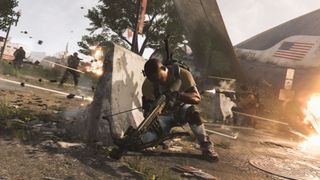
Capital city
The difference in setting between The Division and its sequel is fairly striking. The open world of the original often felt oppressive and claustrophic, the streets of Manhattan boxed in on all sides by concrete and steel. Even after just a few minutes in Washington D.C., it immediately feels different.
Even after just a few minutes in Washington D.C., it immediately feels different.
With more wide-open spaces players have longer sightlines, but at the same time I felt a bit more wary while running around because without tall buildings protecting my flanks as I ran, the enemy in The Division 2 could be anywhere and in any direction. The demo didn't cover a whole lot of ground, but even the small area I played got me interested in seeing the rest of DC, and finding out how much the more open open world changes squad tactics, combat, and exploration.
The demo began with a quick skirmish in a courtyard where civilians were being threatened with execution by some armed goons, but after quickly dispatching them and rescuing their captives, we continued on to a soggy open field where Air Force One had crash landed (quite some time ago, from the looks of it). Unlike the first game, this isn't a city in the grip of a disaster, but one attempting to recover from it. Some abandoned residential and commercial areas are already being reclaimed by nature. There are no more grim and snowy nights in a world of asphalt: it's still plenty grim, but it's summer, and plants are growing and even reclaiming residential and commercial areas that have been abandoned the citizens of the city.
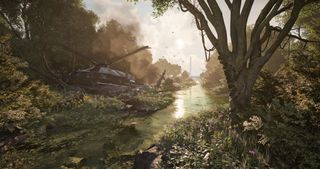
Signature style
Despite the battle for Air Force One taking place in a wide-open area, The Division 2 is still a cover-shooter, and various wrecked cars, concrete slabs, and other conveniently placed debris resulted in a fight that didn't feel all that different than combat in the original. There were, however, some new ways to fight.
As announced at Ubisoft's E3 presentation, there are three signature weapons that become available once you've completed the campaign and reached the level cap: a crossbow, a grenade launcher, and a sniper rifle. My level 30 character had the crossbow, and while I began the demo with no ammo for it, I collected some as we progressed through the mission and put it to use.
The biggest gaming news, reviews and hardware deals
Keep up to date with the most important stories and the best deals, as picked by the PC Gamer team.
The crossbow was armed with explosive arrows, and I was happy to learn that even when I missed a shot it could do plenty of damage. The arrows don't detonate on impact: there's a delay, so even if you miss your target but hit an object near him, he'll still take damage from the explosion. Same goes if you hit him and there are other enemies in the vicinity. I couldn't rely on it too heavily due to the sparseness of ammo, but skewering one enemy who'd then explode and damage everyone around him made for a nice area-of-effect attack.
Another feature in the demo was the ability to call in NPC reinforcements. In The Division 2, some citizens have banded together and built settlements to protect themselves from the roaming enemy factions, and when you help out these settlements (precisely how you help them hasn't been made clear yet) they'll be able to give you help, too. Calling them in resulted in a small mob of armed citizens who joined the fight on our side. It's hard to judge how effective they were, but at the very least they drew some fire from the bad guys which made the battle a bit easier to manage.
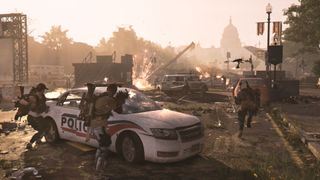
Big boss
Spotting medics and taking them out quickly saves you a lot of work later.
There were a few new enemy types in the demo, too. One particularly troublesome enemy carries a weapon that shoots a river of foam at you, and that foam hardens instantly, first slowing you down and then rooting you in place until another player shatters it for you. It's honestly kind of comical to be engaged in a tense battle with heavily armed goons and then see a pressurized stream of foam go squirting past you, as if Morgan Yu from Prey just showed up and joined the battle.
Another enemy unit to watch out for: medics who come to the aid of your fallen foes. You don't want to pump bullets into a grunt and watch him drop, only to see a medic rush over and pick him back up while you're reloading. Spotting medics (they're marked with a different color icon than the common grunts) and taking them out quickly saves you a lot of work later.
Several times during the demo enemies managed to blitz from several directions, usually by slipping around the sides of my squad. Without those Manhattan skyscrapers keeping your flanks clear, calling out enemy positions is important, as is keeping an eye on enemies at the fringes of your vision. Look away and they can easy slip around and encircle you.
The fighting around the remains of Air Force One set the stage for the appearance of a heavily armored boss, whose protective shell needed to be chipped away before we could do any real damage to him. He also advanced on us while throwing explosives ahead of him which forced us to displace from cover and even fall back until enough of his armor had been blasted off and he could be dispensed with.
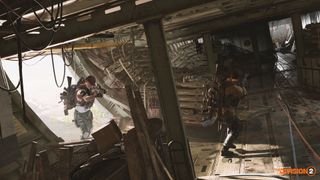
After we reclaimed the Air Force One control point, the bad guys called in their own reinforcements, and now instead of attacking we were forced to defend, along with our NPC allies. More grunts, foamers, medics, and another armored boss, who seemed identical to the first one, appeared. While the boss was very much a bullet sponge, and I definitely didn't need to see him twice in the same demo, it was still an exciting and pretty challenging fight.
Even with my new crossbow and a few new enemies, combat ultimately wasn't a terribly different experience from the original. If anything has me excited about seeing more of The Division 2, it's the setting. I appreciate the change of venue: not just that it's a different city but that it's a different kind of city. Without being surrounded by skyscrapers, the world feels less claustrophobic but at the same time a bit more dangerous.
Apart from that small slice of demo, Ubisoft isn't saying much about the rest of the Division 2 just yet. There will be some version of Manhattan's Dark Zone, the dangerous and atmospheric PvP area, but Ubisoft wouldn't answer my questions about it during the event, and they wouldn't elaborate further on the 8-player raids, either. Then again, there's quite awhile before it comes out: The Division 2 launches on PC on March 19, 2019, and by then I'm sure we'll know a lot more.

Chris started playing PC games in the 1980s, started writing about them in the early 2000s, and (finally) started getting paid to write about them in the late 2000s. Following a few years as a regular freelancer, PC Gamer hired him in 2014, probably so he'd stop emailing them asking for more work. Chris has a love-hate relationship with survival games and an unhealthy fascination with the inner lives of NPCs. He's also a fan of offbeat simulation games, mods, and ignoring storylines in RPGs so he can make up his own.
Most Popular


